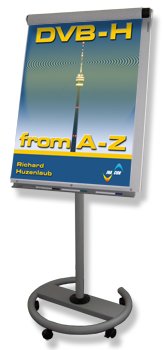 DVB-H from A-Z
DVB-H from A-Z
[2-day course, Euro 2,350.- (net) per participant]
 Overview of Broadcast / Multicast Technologies
Overview of Broadcast / Multicast Technologies

- Important Digital Video and Audio Broadcasting Technologies
- In this section an overview of the most important standards for digital broadcast and multicast should be provided, such as DVB (DVB-S, DVB-T/H), DMB, MBSAT, ATSC, MBMS and also some indication for their applicability (e.g. stationary, mobile or in car use).
- Broadcast / Multicast in 3G and 4G Networks - MBMS
- This section outlines MBMS as a potentially competing or complementing technology from the 3GPP point of view: Network Architecture, Operation Modes, Protocol Stack overview and Data rates.
- Overview of a DVB system
- This section provides a DVB classification and briefly outlines the different variants, evolutions and applicability, the key differences in content distribution (via satellite, terrestrial, via cable) and common functional modules.
- DVB-H as mobility enhancement to DVB-T
- This part will summarize specific DVB-H features for the physical layer and the link layer that have been specified based on the DVB-T standard (TPS, MPE-FEC, Time-Slicing, Handover Support, IP datacasting, power saving mechanisms).
- Comparison between DVB-H and some other broadcast technologies
 Terrestrial DVB transmission with DVB-T
Terrestrial DVB transmission with DVB-T
- DVB-T Architecture Overview and Operation
- We will Identify all functional blocks (source encoding, transport multiplexing – MPEG2-TS, channel adaptation, modulation for digital terrestrial television).
- Frequency Spectrum and Bandwidth
- DVB-T Code Rate and Physical Parameters
 Fundamental Technologies
Fundamental Technologies
- Introduction of MPEG
- This section will provide a MPEG standards roadmap as an overview to clarify terms and definitions and will then focus on streams (ES, PES, MPEG2-TS) and the frame structures rather than on video / audio compression algorithms.
- OFDM in DVB-T/H
- This section will explain the basics of OFDM and the application in DVB-T with different subcarrier modulations (2K and 8K modes with QPSK, 16-QAM or 64-QAM) in detail.
 DVB-H – Mobile TV to the Handheld Terminal
DVB-H – Mobile TV to the Handheld Terminal
- Overview of the enhancements compared to DVB-T
- The DVB-H System Architecture in Detail
- DVB-H Physical Layer Features
- This section explains the usage of the DVB-T physical layer transport, multiplexing capability with DVB-T and DVB-H services on the same transport, IP based MPE over DVB-T, the additional TPS signaling and the additional mode with 4K OFDM subcarriers.
- This section explains the usage of the DVB-T physical layer transport, multiplexing capability with DVB-T and DVB-H services on the same transport, IP based MPE over DVB-T, the additional TPS signaling and the additional mode with 4K OFDM subcarriers.
- DVB-H Link Layer Features
- This section explains in detail MPE-FEC and the impact on C/N performance, Time Slicing and the impact on power saving and DVB-H Handover.
- Consideration of interactive services
 IP Datacast over DVB-H
IP Datacast over DVB-H
- Protocol Stack Overview of DVB-H
- This section details the DVB-H protocol stack from an end to end service delivery point of view.
- DVB service delivery details
- We will explain service discovery based on ESG, service bundles and service sessions for content delivery. This will also include a detailed description of Service Information (SI) and Program Specific Information (PSI) data structures.
- Overview of transport independent service delivery protocols
- An overview of the important service delivery protocols for streaming services (RTP/SRTP/RTCP) and download services (FLUTE) will be provided in this section..
- Service Purchase and Protection
- This section explains the security architecture for DVB-H services
 Selected Scenarios and End to End Operation
Selected Scenarios and End to End Operation
- Access to Free-To-Air Content
- Electronic Service Guide (ESG)
- Streaming Service and File Download
v1.100
ℹ️ Try out the updated search below!
Search:
More Info:
General Information about this course
Schedule of this training course
Buy this book
INACON eBooks
Please have a look at our full offer

